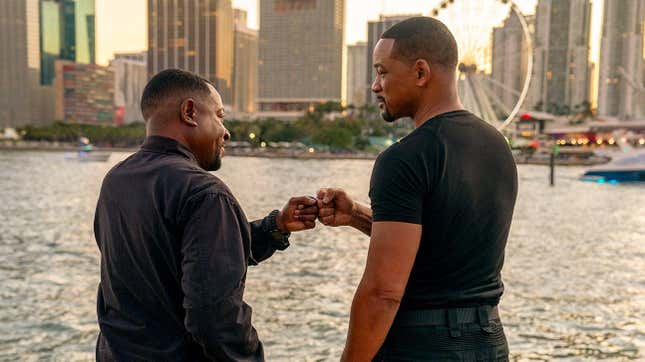
Technically speaking, only the climax of Bad Boys: Ride Or Die takes place in an abandoned amusement park. But really, isn’t any movie that begins with the logo for Don Simpson/Jerry Bruckheimer Films situating itself in a long-neglected playground of cheaply conceived yet lavishly budgeted thrills? When Mike Lowrey (Will Smith) and Marcus Burnett (Martin Lawrence) burst onto the scene in 1995, they were announcing the promotion of a couple beloved TV comedy actors to big-screen men of action; even the original film’s switched-places hook felt like a steroidal sitcom, courtesy of comedy exploder Michael Bay. By pumping up the action alongside the profane banter, Smith and Lawrence were also taking over as next-gen Eddie Murphy figures within the same Simpson/Bruckheimer universe that produced the first two Beverly Hills Cop movies. Nearly 30 years later, Marcus and Mike are legacy characters, a welcoming home where Smith and Lawrence can return during uncertain times for major stars. (No coincidence, surely, that Murphy himself is about to reprise Axel Foley for his own summer fourquel that shares a co-writer with Ride Or Die.)
Perhaps it’s that sense of comfort that explains the relative gentility of these solidly middle-aged boys. Yes, Bad Boys: Ride Or Die does open with off-duty police officers shooting a convenience-store robber and promptly leaving the scene—boys will be boys! Especially if those boys are cops!—but it’s easy to imagine a nastier version of events unfolding circa Bad Boys II, maybe involving our heroes stepping on the robber’s wounds to grind the bullet in a little deeper. What’s more, Mike and Marcus are on their way to Mike’s wedding; he’s marrying his therapist Christine (Melanie Liburd)—physical, the movie is quick to point out, not mental, though she’s not blind to what she’s getting into. “I had some growing up to do,” Mike says reflectively about his settling down, to which Christine responds, deadpan: “You’re 50.”
Accordingly, when Marcus has a brush with death at the reception, it’s not via a hail of assassin’s bullets; he suffers a heart attack, and emerges from the experience feeling more enlightened about his place in the universe—and also convinced that he cannot be killed. (To be fair, the three previous Bad Boys movies provide ample evidence supporting his claim.) This subplot brings out a warmly loopy side to Lawrence; there’s something charming to his half-baked riffs about his realization that he and Mike have known each other in many past lives. But Marcus must set aside these spiritual musings when the boys learn that Captain Howard (Joe Pantoliano), their longtime, always-apoplectic boss who died in the previous film, is being posthumously framed as a cartel mole. Their attempts to clear his name lead back to Mike’s imprisoned adult son Armando (Jacob Scipio), who joins the boys in a brief Fugitive variation set up by the real bad guys. (Anyone fooled by the identity of one bad guy in particular is in danger of being preyed upon by Rufus Sewell.)
The ensuing pyro feels more judiciously managed than the mega-Bayhem of Bad Boys II. Adil El Arbi and Bilall Fallah, the filmmaking duo credited as Adil & Bilall, took over the series with the belated third installment and return here with even more passages of hopped-up, neon-lit, candy-colored stylization. At its best, Ride Or Die feels as wacked-out as later-period Bay, without the sense that its filmmakers are rage-directing their way through some kind of unspecified, omnidirectional anger issues; Adil & Bilall seem genuinely tickled to figure out how they can work in such a variety of gun’s-eye-view shots into their action scenes, execute 90-degree camera tilts, or engineer a shoot-out to send a gigantic bowl of jelly beans cascading through the air.
Yet there’s also something slightly ersatz about the way the movie settles down between extended action sequences—of which there are about three, all lizard-brained blasts. When it comes to staging dialogue scenes inside office buildings or vehicles, suddenly Bad Boys: Ride Or Die is as flatly overcast as any streaming-service legacy sequel, as if a certain allotment of digital resources have been earmarked for drone-camera craziness and death-dream hallucinations, while the rest must be dutifully spent on cost-efficient drabness. But if this makes it look like Adil & Bilall are expending more visible effort on the action-movie freak-outs than Bay, they compensate when it comes to teasing out charm and humor, which they’re able to do without goading their actors into sweaty agitation. With its multiple returning characters (Vanessa Hudgens and Alexander Ludwig are retained as next-gen badasses), soapy family plotlines, terribly acted cameos, and even its subtitle, Bad Boys: Ride Or Die has clearly glommed onto a more Fast & Furious sensibility in its middle age, albeit with hard-R violence and swears. It’s equally calculated and sweet (well, maybe somewhat more calculated) that Smith and Lawrence no longer assume they can get away with Bad Boys II-level nastiness.
Is it really better for a movie to disguise its bloodlust with more avuncular shtick? Hard to say. Harder still when slick, starry action movies in the Simpson/Bruckheimer mode have become so rare that Bad Boys: Ride Or Die feels like a retro outlier even when the camera escapes the cruel pull of gravity. As the boys approach that abandoned amusement park, a bit of carny-barker set-up incorporates a giant alligator and the phrase “legend has it,” which should make for an incongruous fit in a movie where an aging Mike Lowrey has a panic attack. (Yes, the Bad Boys movies are now apparently aspiring to matching the level of touching character development afforded a Mario Brother.) Somehow, it doesn’t clash—or it at least achieves a kind of dumb-fun equilibrium that encourages a summery brand of surrender. Like the theme song says: Whatcha gonna do?